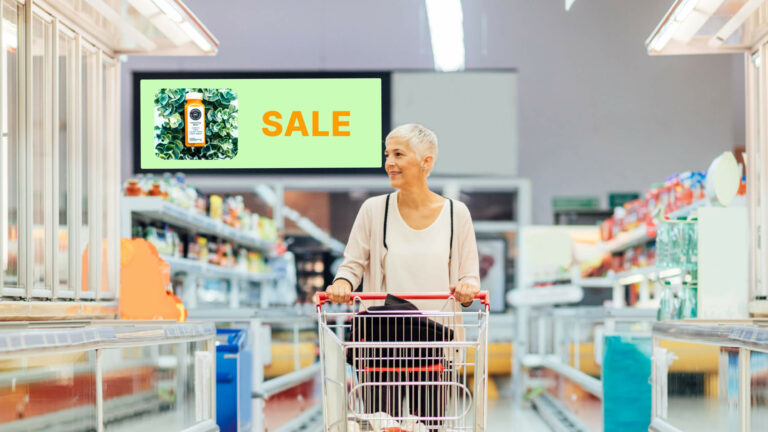How to Reach Shoppers Throughout the Customer Journey Using Your Retail Media Network

Retail media is a form of digital signage used to advertise products and events to shoppers. One of the benefits of retail media networks is that they are installed in locations where shoppers are already gathering. This makes retail media an effective way to reach current customers and attract new ones.
Retail giants like Walmart, Target, Home Depot, and Kroger are already leveraging the power of in-store digital advertising to increase sales. And with smaller, independent shops following suit, it is estimated that the retail media market will grow by 25% per year to $100bn over the next five years. And it will account for over 25% of total digital media spending by 2026.
Want a piece of the pie? Keep reading to find out more about retail media and how you can build and control an effective digital signage network with Wovenmedia solutions.
What is a retail media network?
An online advertising network, or ad network, connects businesses that want to run ads with websites that are looking to host them. The principal attribute of an ad network is the gathering of ad space and matching it with the advertiser’s needs. So, ad networks work with publishers across the internet, helping anyone who has unsold inventory or ad space and wants to monetize what they’ve got. They assemble the empty spaces, parcel them off, and sell them to advertisers.
The same idea can be applied to the retail space. This is an opportunity for brands to market their products to shoppers in-store. Ads can be displayed in various formats at different points throughout the customer journey. From right before customers enter the store to when they’re checking out. Ads strategically placed near the point of sale are more likely to grow your revenue – but don’t wait until your audience is in line. Start grabbing their attention as they go around the store.
How to reach shoppers at different points in their journey
Online grocery shopping is a rapidly growing niche that’s set to become worth upwards of $250bn in the US by 2025. With more and more people shopping this way, it’s no wonder brands invest a big chunk of their budgets in online advertising: paid search, social media ads, influencer promotion, display ads, and brand deals.
But there is still a significant audience to be reached in physical stores. 46% of Americans visit grocery stores every week. Research shows that shoppers go to the supermarket between 1-2 times a week, spending an average of 40 minutes in-store on every visit. Keep reading to find out how you can reach them with as much accuracy as online customers using your retail media network.
Best practices for building a retail media network with in-store digital advertising
1. Build your digital signage network using an all-in-one content management system
Creating a digital signage network in-store allows you to send targeted messages to shoppers at precisely the right points along their journey. Networks can be built using different kinds of displays depending on their intended purpose. For example, tv walls, menu boards for in-store cafes, projectors, and more. This flexibility allows retailers to share information, adverts, and promotions, in a way that will make sense to customers.
A robust content management system (CMS) is essential to helping you target your content effectively. With WovenManager, you can schedule your content to play at a specific time and day of the week, on one screen, or across your entire network. Proof-of-play reports are automatically generated to share with advertisers, so you know what’s playing when and where. And whether it’s working to increase sales.
Learn how to measure the effectiveness of your digital screens with Wovenmedia. Get your free guide.
2. Consider dwell and traffic patterns
The setup of your digital signage network requires careful consideration. When deciding where you’re going to put your screens, you need to think about where they will make the most significant impact. Spend some time studying dwell and traffic patterns in your store(s) before installing anything.
Often, you’ll find dwell time is the problem. There’s not a lot of it happening. Shoppers want to be in and out of supermarkets, pick up what’s on their lists and go home. They’re not stopping long enough to look at signs. The one place you get a lot of dwell is at the checkout, but to see a difference in sales, you ideally want to stop your customers before then. Retailers with kiosks or other dwell spots, like pharmacies, need to take advantage of the people waiting and install screens here.
3. Pay attention to audience patterns
You’ve probably noticed that traffic in your store varies on different days and at different times throughout the week. If not, it’s time to start paying attention. Supermarkets in the US are generally quieter Monday – Thursday, when traffic only really starts to pick up between 4 pm – 5 pm, thanks to the after-school or after-work rush. Research suggests that grocery stores are quietest on Wednesday mornings, with traffic reaching its peak between 11 am – 12 pm on Saturday.
If you look, you’ll also see your audience is made up of different demographics at different times during the week. Older shoppers, younger shoppers, shoppers with varied interests, more leisure time, less disposable income, etc. Once you understand who’s more likely to come in when, what their interests are, and when traffic is heaviest, you can tailor your playlists and start reaching more people with targeted promotions and ads.
4. Use Your Retail Network to Connect With Shoppers & Use Monetization to Your Advantage
A popular place to install screens/displays is at the checkout line. Typically, there’s more space in this section of the store, and you have a captive audience while shoppers wait to be served. The only problem is being too close to the point of sale. You’re nearly at the end of the customer journey, so endemic ads have less power here.
- Endemic advertising: Ad placement where it is native or natural to its market.
- Non-endemic advertising: Ad placement in a non-native environment brands, where can still profit from, e.g. sponsored ads.
Checkout displays that offer deals on products that are right there can increase sales on certain items. But in general, non-endemic ads outperform store promotions in the queue. This creates an opportunity for retailers to expand and monetize their retail media network by hosting third-party ads that encourage shoppers to take action after they’ve left the store.
Promote local businesses on screens in your stores, using location services on your CMS to control which content is played where.
Get the inside story on how Sam’s Club reaches 30 million viewers a month across their 590+ locations in North America, plus find out how you can imitate their success with Wovenmedia. Download the webinar slides now.
Get started with Wovenmedia
Digital signage has many practical – and profitable – applications in the retail sector. Retailers can use their screens to display offers, share news/announcements, guide customers through their stores, and more. They can even make some of their money back by partnering with other brands and advertising their products and services.
Start building your retail media network with Wovenmedia. Our full-service digital signage software includes everything you need to create custom playlists and channels, communicate your brand message with customers, and grow your revenue through advertising partnerships.
Get in touch with our team of experts today or sign up now for a free 30-day trial, with all features included, to see how it works.






